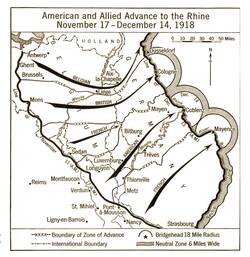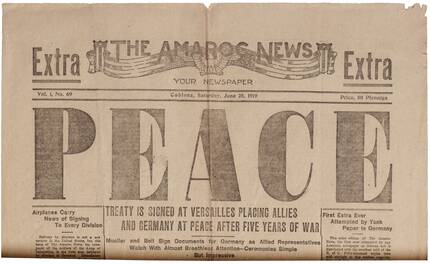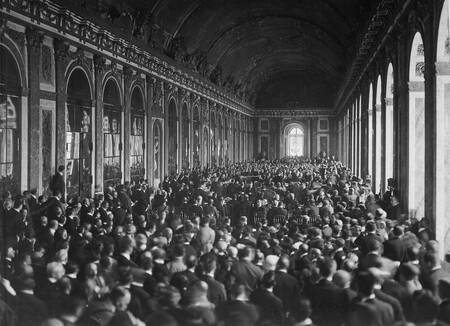Armistice and Peace Negotiations
The 11th of November 1918 marked the defeat of the German Empire and the end of the German monarchy, which was soon replaced by the democratic “Weimar Republic.” The Armistice of Compiègne called for a large-scale German demilitarization, pulling back all German forces behind the Rhine River. To make sure that the Germans would follow the terms of the armistice, the Western Rhineland, including bridgeheads on the Eastern bank of the Rhine around Koblenz, Cologne and Mainz, was to be occupied by the victorious powers. This territory was then divided up into four occupation zones: Belgian, French, British and American. The Headquarters of these zones were in Mainz, Aachen, Cologne and Koblenz.

- Map of the marching route of the Allied (Belgians, British, French) and American forces into their assigned occupation zones along the Rhine until December 14, 1918. Important are the bridgeheads east of the Rhine around Cologne, Koblenz and Mainz. Following strategical demands they were simply drawn with a compass, ignoring geographic conditions (VII. Corps Historian: American Armies and Battlefields in Europe. Washington, D.C. 1938).
President Wilson’s Fourteen Point Proposal failed to gain the support for a lasting peace. Instead, the victorious nations acquired land as well as monetary and material reparations in quantities still to be defined as part of the Peace Treaty of Versailles, which was signed on June 28, 1919. This treaty also stipulated that Germany and its allies were responsible for the war, justifying the compensation and strict regulations against Germany.
An additional “Rhineland Agreement” set terms for the continuation of the occupation, establishing the Inter-Allied Rhineland High Commission as a supreme civilian governing agency. Local administration remained intact to handle daily affairs. The occupation forces made requisitions of billets and controlled all lines of transportation and communication, with Germany paying for the entire cost of the occupation armies. The treaty came into effect on January 10, 1920. However, since the American Senate eventually refused to ratify the Treaty of Versailles, Germany and America continued to be in a technical state of war, making the occupation more difficult.



